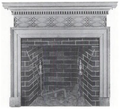Fireboard
Panel to cover a fireplace during warm months of the year From Wikipedia, the free encyclopedia
A fireboard or chimney board is a panel designed to cover a fireplace during the warm months of the year.[1] It was "commonly used during the later 18th and early 19th centuries"[2] in places like France and New England. In warm weather, "a fireboard effectively reduced the number of mosquitoes and other insects, or even birds, that might enter a house through an open, damperless chimney."[3] The "board or shutterlike contrivance" typically "of wood or cast of sheet metal"[4] is "frequently decorated with painting and stencilling."[2] Some fireboards have notches cut out of the lowest edge to accommodate andirons.[3] Fireboards are also called: chimney boards, chimney pieces, chimney stops, fire boards, summer boards.
Among the many artists who have produced ornamental fireboards: Robert Adam; Winthrop Chandler (1747–1790);[1] Andien de Clermont;[5] Charles Codman;[1] Michele Felice Cornè;[1] Edward Hicks;[6] Jean-Baptiste Oudry;[5] Rufus Porter.[1] Examples of decorated fireboards are in numerous collections, including: Historic Deerfield, Massachusetts;[7] Historic New England; National Gallery of Art, Washington, DC, USA;[8] Peabody Essex Museum; Victoria & Albert Museum.
Images
- Fireboard with view of Chatsworth, Derbyshire, England, by M.F. Corné
- Fireboard decorated with trompe-l'oeil image of a fireplace and mantel, ca.1825 (Historic New England)
- Cat and Canary fireboard, France, ca.1830-1840 (Cooper Hewitt Museum)
- Great Gale of 1846 fireboard (Peabody Essex Museum)
- Fireboard by Grandma Moses, 1918
- Banister House, Brookfield, Massachusetts, USA (photo 1936) (Library of Congress)
References
Further reading
External links
Wikiwand - on
Seamless Wikipedia browsing. On steroids.





